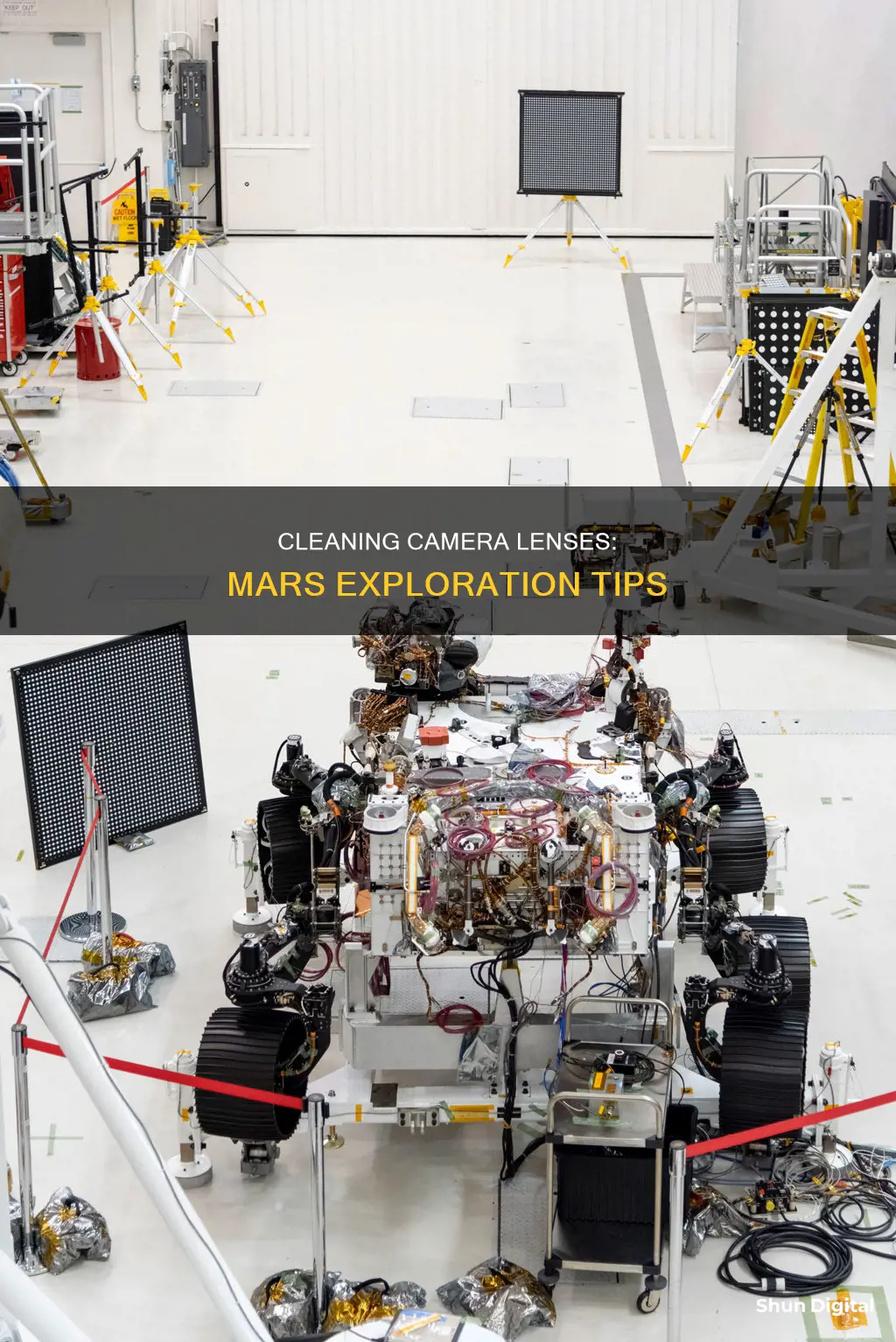
Keeping camera lenses clean on Mars is a challenging task due to the presence of dust and the absence of fogging from moisture. One effective method is to use lens covers, which protect the lenses from blowing dust when not in use. Additionally, positioning the cameras higher off the ground, such as on a mast, reduces the amount of dust that settles on them. Mars also experiences dust devils, similar to small tornadoes, which can blow dust off the rover and its cameras. While there are no direct cleaning systems, atmospheric winds can help clean the lenses to some extent. Preventing dust buildup until it affects the quality of operation is the current strategy, along with using self-correction software to compensate for dirty spots on the lenses.
| Characteristics | Values |
|---|---|
| Camera lens cover | Cameras near the surface of Mars have a cover to protect the lens from blowing dust |
| Camera angle | Cameras are pointed downwards to prevent dust from settling on the lens when not in use |
| Camera height | Cameras are placed high off the ground to avoid blowing dust |
| Camera position | The camera mast is tilted downwards when the rover sleeps |
| Camera movement | The camera mast turns away from dusty areas when the rover is drilling or scooping |
| Dust removal | There are no systems in place to directly clean the lens; instead, atmospheric winds are used to "clean" lenses |
| Self-correction software | Cameras can detect if a particular area of pixels is missing and adjust for it |
What You'll Learn

Use a cover to protect the lens from blowing dust
Keeping camera lenses clean on Mars is a challenging task due to the constant presence of blowing dust. One effective strategy is to use a cover to protect the lens when it is not in use. This method has been successfully employed by Mars rovers such as WATSON and MAHLI (the Mars Hand Lens Imager), which have utilised lens covers to maintain image quality.
Lens covers serve as a barrier against blowing dust, ensuring that the lens remains clean and clear for capturing optimal images. These covers can be opened when the camera is in use and closed at other times, providing a simple yet effective solution to the issue of dust accumulation. This approach is particularly useful for cameras positioned near the surface of Mars, where the risk of dust contamination is higher.
The use of lens covers also eliminates the need for complex or invasive cleaning mechanisms, which could potentially damage the delicate lens surface. By keeping the lens physically protected, the rover avoids the risk of scratches or other types of damage that could degrade image quality over time.
Additionally, the lens cover strategy aligns with the principle of "prevention is better than cure." By preventing dust from settling on the lens in the first place, the rover avoids the need for frequent and potentially hazardous cleaning operations. This approach not only simplifies the maintenance of the camera system but also ensures the longevity of the lens by minimising exposure to harsh Martian conditions.
It is worth noting that lens covers may not be the sole solution for all cameras on a rover. For instance, cameras positioned higher off the ground, such as those on the mast, may experience less dust accumulation due to their elevated position. In such cases, the use of lens covers may be unnecessary, and other strategies, such as tilting the mast downwards when the rover is inactive, can be employed to minimise dust exposure.
The Ultimate Camera Lenses for Professional Photography
You may want to see also

Point the camera downwards to avoid dust collection
To keep camera lenses clean on Mars, it is recommended to point the camera downwards to avoid dust collection. This technique was first mentioned during a press briefing when someone asked, "How do you prevent dust from building up on the lenses?"
Pointing the camera downwards helps prevent dust from settling on the lens when it is not in use. This is especially important on Mars, where dust storms are common and can cause significant dust buildup on surfaces. By keeping the camera pointed downwards, you can minimise the amount of dust that settles on the lens, reducing the need for frequent cleaning.
Additionally, using lens covers can also help protect the lenses from dust. These covers can be opened when taking pictures and closed at other times to keep the lenses clean. This method was used during the descent of the rover, with transparent covers protecting the lenses until they reached the planet's surface.
Another strategy is to position the cameras higher off the ground, as there is less blowing dust at elevated heights. This approach was utilised by the Curiosity rover, which experienced less dust buildup on its cameras due to its height.
Furthermore, the mast of the rover can be tilted downwards when it is not in use, similar to how a person might turn their face away when sanding to avoid getting dust in their eyes. This technique helps prevent dust from settling on the lenses.
Overall, by pointing the camera downwards, using lens covers, positioning cameras higher off the ground, and tilting the mast downwards, you can effectively minimise dust buildup and keep camera lenses clean on Mars.
Sigma Lenses: Compatible with Full-Frame Cameras?
You may want to see also

Use a robotic arm to shield the lens
The Perseverance rover has a five-jointed robotic arm that can be used to shield its camera lens from dust. The arm has a camera of its own, called WATSON, which has a cover to keep the lens clean when not in use.
The robotic arm can be used to shield the camera lens from dust in several ways:
- The arm can be positioned to block dust from reaching the camera lens. This can be done by lowering the arm or moving it to the side of the rover.
- The arm can be used to wipe away dust from the camera lens. The arm has a turret of tools at the end, which could be used to gently brush away any dust.
- The arm can be used to create a barrier between the camera lens and the direction of the wind, reducing the amount of dust that reaches the lens.
- The arm can be equipped with a lens cover or a lens filter to protect the camera lens from dust. The cover or filter can be removed when the camera is in use and replaced when it is not in use.
It is important to note that the robotic arm should not be used to touch the camera lens directly, as this could scratch or damage the lens. Instead, use the tools or covers mentioned above to shield the lens from dust.
Student Photography: Affordable Camera Lenses for Beginners
You may want to see also

Take advantage of dust devils to blow dust off
Dust devils, or "cleaning events", can be used to blow dust off camera lenses on Mars. These are common on the planet and can be utilised to clean the lenses of the Mars rovers.
Dust devils are essentially whirlwinds, which can be used to the advantage of the camera equipment on Mars. They are capable of cleaning the solar panels of the rovers, and the same can be done for the camera lenses.
The dust devils can be allowed to blow the dust off the lenses, and this method can be used in conjunction with other techniques to ensure the lenses are kept as clean as possible. The rover can be positioned to take advantage of the dust devils, such as tilting the mast down when the rover is "sleeping". This prevents dust from settling on the lenses.
The dust devil method can be used in addition to other cleaning techniques, such as using lens covers, and tilting the camera down when changing lenses. The lenses can also be kept clean by using a blower, brush, or cloth to manually remove dust.
Anti-Camera Lenses: Worth the Investment?
You may want to see also

Use a lens-cleaning solution
Keeping your camera lens clean is essential for capturing clear, sharp images. Here are some detailed instructions on how to use a lens-cleaning solution to maintain your camera equipment, especially in the challenging environment of Mars:
Choosing a Lens-Cleaning Solution:
- Opt for a specialised lens-cleaning solution designed for camera lenses and optical surfaces. These solutions are formulated to safely remove contaminants without causing streaks or damage.
- Avoid alcohol-based lens cleaning solutions. Alcohol can leave streaks and sharp objects behind on your lens, which may scratch the surface.
- Look for a non-alcoholic solution that effectively removes fingerprints, water-based contamination, and oil-based contamination.
Using the Lens-Cleaning Solution:
- Always refer to the instructions provided with your chosen lens-cleaning solution.
- Spray the lens-cleaning solution onto a soft, lint-free microfiber cloth. Avoid using paper towels or tissues, as these can be too rough and leave lint behind.
- Gently wipe the lens with the cloth, using gentle, circular motions. Ensure you are wiping in one direction only, not back and forth.
- Polish the lens until it is completely dry.
- For more intensive cleaning, use a two-cloth method. Wear gloves to avoid transferring oils from your fingers to the lens. Use one damp cloth to clean the lens, followed immediately by a dry cloth to remove any remaining solution and contaminants.
- Be cautious when cleaning the back of the lens, as this area is more susceptible to damage from dust and streaks.
- If using a spray solution, ensure it does not come into contact with the camera body, as liquid can seep into the camera and cause damage.
- Always store and transport your lens-cleaning solution safely, especially when travelling to Mars!
Additional Tips:
- Before using any liquid or solution, try using a rocket blower or air bulb to remove dust and loose particles from the lens.
- For more intensive cleaning, a lens pen can be useful. These tools have a soft brush on one side and a rubber suction tip on the other, effectively removing dust and particles without liquid.
- Be cautious when using canned air, as it can sometimes spray condensation, which may damage your lens or camera sensor.
- Microfiber cloths are useful for removing oil and fingerprints, but ensure they are clean and specifically designated for lens cleaning. Wash microfiber cloths by hand with cold water and dish soap, avoiding laundry detergents or hot water, which can leave fibres and minerals behind.
- Avoid using t-shirts, breath, or other makeshift cleaning methods, as these can scratch your lens over time and may contain substances harmful to the lens coating.
Camera Lenses: Do They Age Like Wine or Rust?
You may want to see also
Frequently asked questions
Mars has a thin atmosphere, so dust is unlikely to be blown onto the lens. However, to be safe, you can use a transparent dust cover to protect the lens. Make sure to only remove the cover when taking pictures.
If your lens gets dirty, tilt the camera down to prevent further dust accumulation. Use a manual air blower and a soft-bristled brush to remove dust. Avoid using canned or compressed air as it can damage the lens.
Yes, you can use a lens cover or keep the camera tilted downwards when not in use. Additionally, you can point the lens towards the ground to avoid direct exposure to dust. These methods will help minimise dust accumulation.







